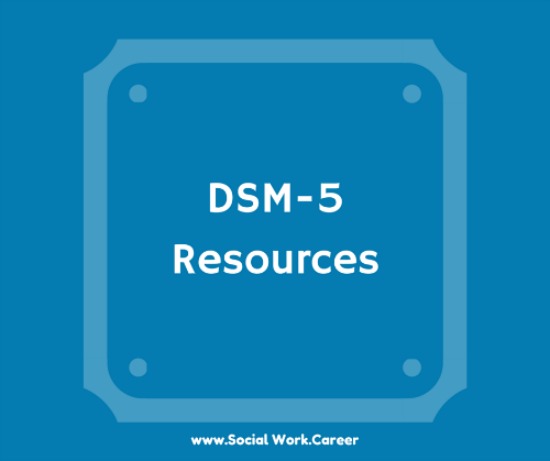Got DSM-5? Watch These Free Webinars!
Are you having trouble wrapping your head around all the changes from DSM IV-TR to DSM V?
No worries. This post will provide you with some excellent handouts, presentations and webinar recordings to help you feel on top of this material.
After many years of negotiation and controversy, the American Psychiatric Association (APA) released the DSM-5 in May, 2013. However, many social workers and other mental health professionals are still in the process of learning and absorbing all of its changes/additions. Change takes time… and it is a lot of information to absorb.
Quick Overview of DSM-5
- It moves away from the categorical model and recommends scientifically-validated assessment measures, rating scales in diagnosis, monitoring and measuring treatment progress and assessing impact of culture in key aspects of clinical presentation and care.
- It is organized via the developmental life-span; for example, developmental disorders are presented early in the listing of disorders.
- The restructuring of chapters in DSM-5 was based on disorders’ relatedness to one another, as well as symptom vulnerabilities and symptom characteristics.
- Much of DSM-5 is unchanged from DSM IV-TR, and it contains approximately the same number of diagnoses. While some diagnoses were reclassified or removed, only 15 new diagnoses were added. DSM-5 also offers clarification of certain diagnostic criteria.
- No More Axes – Switch to non-axial documentation of diagnosis.
- Axis III is combined with Axes I and II and physical health conditions are simply to be listed.
- Axis IV is eliminated. Instead, psychosocial and environmental issues are represented by ICD-9 V codes and ICD-10 Z codes.
- The Axis V – GAF score was eliminated.
Below are three wonderful presentations (slides and webinar recordings) provided by Gary M. Henschen, M.D at Magellan about the DSM-5.
Part I outlines the changes under DSM-5, including the restructuring of autism, ADHD, schizophrenia, and other diagnostic categories. Part II covers depressive disorders, anxiety disorders, obsessive-compulsive and related disorders, trauma and stressor-related disorders, dissociative disorders, somatic symptom and related disorders, and eating and feeding disorders.
Part III discusses elimination disorders, sleep-wake disorders, sexual dysfunctions, gender dysphoria, disruptive, impulse-control, and conduct disorders, substance-related and addictive disorders, neurocognitive disorders, personality disorders, paraphilia disorders and other mental disorders. It also covers medication induced movement disorders, and other conditions that may be a focus of clinical attention.
Here are DSM-5 Assessment Tools, and below are some links to topical webcasts for those of you who would like to go into more depth on some of the changes.
Additional DSM-5 Free Webinar Trainings
Autism Spectrum Disorder and Intellectual Disability in DSM-5
Changes in Substance Abuse – DSM-5
Depressive and Grief Disorders
Diagnosis of Dementia to Meet Real World Needs & Sleep/Wake Disorders
The Evolution of Psychosis in the DSM-5
Feeding and Eating Disorders in DSM-5
Mood Disorders in DSM-5: What’s New and What’s Not
PTSD Diagnosis and DSM-5
The DSM-5 and Problem Gambling
Seasonal Affective Disorders – DSM-5 Update
Furthermore, this APA document is a good one to refer to for a summary of all the changes that have taken place from the DSM IV-R to DSM V, and Psychology Charts put together a nice cheat sheet of the DSM-5 List of Mental Disorders with their descriptions.
The APA has also created a series of online assessment tools which includes instructions, scoring information and interpretation guidelines.
MCTAC – CTAC has kindly created a webinar, presentation deck and a best practices handout on the DSM 5 and the Cultural Formulation Interview: What It Is and How to Implement It.
Lastly, the APA has put together a 5 part video series on Substance Use Disorders and Addictions about cutting-edge information about SUDs and addictive behaviors.
I’m hoping that you find these resources helpful 🙂
Magellan Behavioral Health. (2013). 2013 DSM-5 release background and frequently asked questions.
Last updated March 15, 2018.



Very useful as always . Thanks Dorlee .
Wow! Thank you….great idea…keep up great work to support the profession.
Thanks, Gaurav!
Your posts are so informative and interesting! I will certainly pass this along to my colleagues. Keep up the great work Dorlee!
Thanks so much, Sharon 🙂
I most appreciate your kind feedback, as well as your generosity in passing on this post to your colleagues.
Great resource, as always!!
Thanks so much, Nancy !
I’m kind of embarrassed to admit that I typically just look for the numeric code for a particular diagnosis and didn’t even notice that the axes have been essentially eliminated!! I had found Axis V, Global Assessment of Functioning, (GAF), to be especially frustrating as I found the guidelines for a number to be assigned as a GAF to be rather imprecise. Thanks for the valuable information and for keeping me updated Dorlee!! Ernie Wahrburg, LCSW (N.C.)
Hi Ernie,
How kind and brave of you to shared your experience with the DSM 5. My gut feeling is that it is not at all unusual to initially fall back on the DSM IV diagnoses until one remembers – oh wait, that changed… especially when you have many years of valuable of experience behind you.
I also think that your frustration with the GAF is one that many of us have felt and thus, the reason it was eliminated from the DSM V!
Thanks so much for your kind feedback, Ernie
Warmly,
Dorlee
Once again, I come to the internet looking for answers to a social work question and I find your website has everything I need! Thank you so much for creating such a great resource.
Aww, thank you, Rachel!
I most appreciate your kind feedback 🙂
Best,
Dorlee